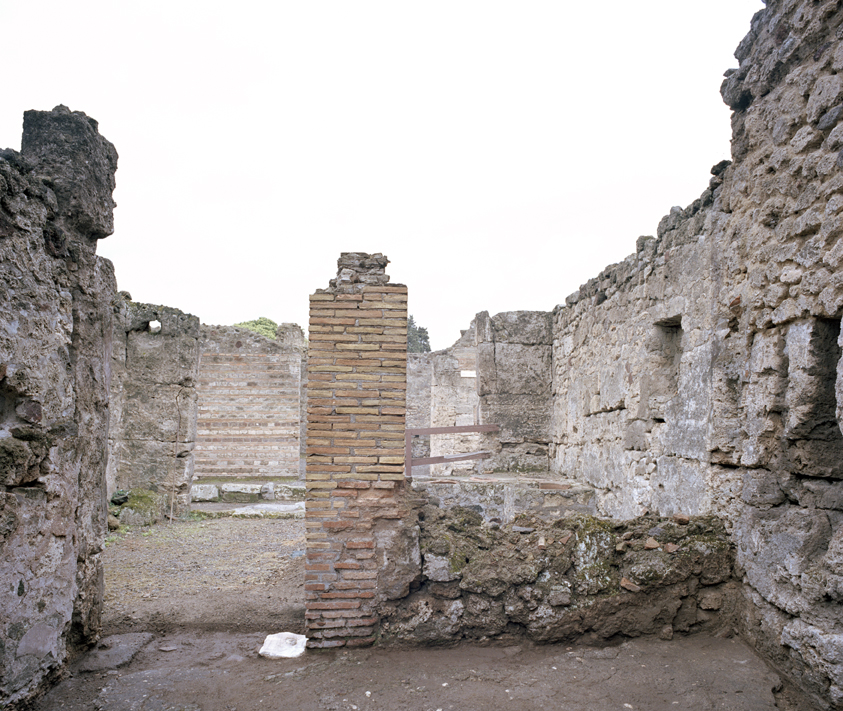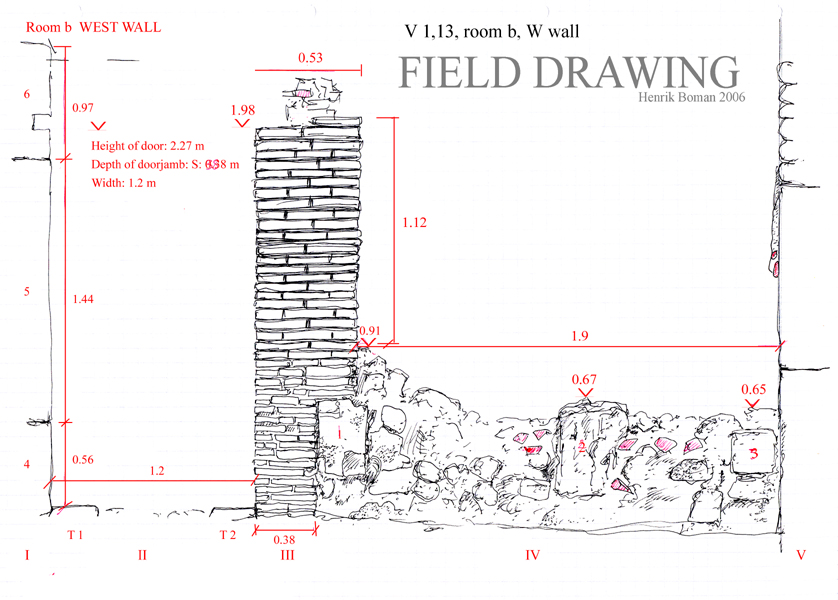West Wall
Description
Henrik Boman & Monika Nilsson
The wall consists of a door way (II), a window (IV) and in between these, a heavily restored brick pier (III). The S doorframe (I) is the W part of the S wall of room b. The wall below the window is in a bad state; the N frame is either missing or the N wall of the insula (V) served that purpose. The lintels are all missing, though the cuttings for the door lintel is preserved in the stone frame of the S wall. The depth of the door seems to have been between 0.38m (S) and 0.43m (N).
I. The southern doorframe
The S doorframe, built of limestone blocks (orthostats), functioned as the western end of the wall between room b and the corridor (c). There are three limestone orthostats (4-6), of which the uppermost (6) has cuttings for the lintel of the door (H: 2.27 m). The cutting is 0.14m high and c. 0.1m deep.
Plaster: Red plaster on a rough, grey UP with large inclusions of terracotta and lime. The terracotta contents indicate that the red FP was intended to be enhanced by the substance in the UP. The plaster is preserved to a height of 2.11m.
Plaster inside the doorframe indicates that no wooden frames were attached, unless the plaster are the remains of an earlier wall decoration. The threshold, however, also indicates that no wooden posts were used. There is preserved plaster along the outer (W) edge of the doorframe, almost in a straight line, which could possibly be an imprint of a wooden exterior frame.
Reconstruction of original layout of S wall: On the E face of the upper two orthostats (5-6) plaster of type A is found (a-b), and we can conclude that the S wall of room b must have been rebuilt at least ones from an originally completely different layout. We can assume that an open space originally extended from the building’s N wall to the S wall, and that the S wall of room b did not exist in this first phase.
II. Door opening
The door opening is 1.2m wide, 2.27m in height, with a threshold stone at each end, but with nothing in between. The threshold pieces (T1-T2), one in lava and one in travertine, are located by each doorframe. The stones have only pivot holes; there are no edges for supporting the closed door, nor any hole for a locking mechanism. Since there are two pivot holes, the door must have been two-folded. The area between the stones is heavily destroyed, though it seems that the lavapesta floor extended over the area of the threshold.
Thresholds:
T1: Lava stone with a single cutting, a pivot hole with traces of iron still visible. The stone is rectangularly cut and no other marks are visible. Dimensions: N-S: 0.28m; W-E: 0.48m.
T2: Travertine with round cutting for a pivot hole, with an earlier round cutting which it partly covers; the former is presumably a recutting of the stone. The shape of the stone is irregular. The side that faces the opening has been cut in a straight line, possible with a wearing down, or a cutting of the edge which makes it lower. The other sides are irregular and unevenly cut. It is presumably a stone that was been recut for this use. Dimensions: W-E: 0.35m; N-S: 0.26m.
In the area between T1 and T2 are small pieces of limestone, tiles and mortar. There are no traces of any feature belonging to the door structure. The area is c. 5 cm lower than the level of the threshold stones, and it seems unlikely that yet a third stone had been placed between them. The lavapesta floor presumably extended over this area, and what remains between the stones is the bedding for the floor.
III. The brick pier
A brick pier functioning both as door and as window frame. Today the pier is 1.98m high, free-standing to a height of c. 1.12m. The upper part is in modern (yellow) brick while the lower, approximately at same height as the preserved opus incertum wall below the window, is ancient red brick. At the lower end, the brick facing is cut back to c. 0.38 m width, located below the window sill. Block 1 is placed at this position.
The core of the pier extends over the top of the preserved (modern) tiles, so we can assume that the (reconstructed) pier has once been higher. One brick is protruding (d), inside the window frame, in line with preserved plaster in room a; this might be an indication of the original height for the widow sill. This line coincides with the modern (yellow) brick.
Mortar: Two different mortars can be seen: a darker mortar in the N lower part, i.e. the part abutting to the opus incertum wall of IV, while the second is a lighter type, consistent with the mortar found in the modern part, continuing down on the S side of the ancient blocks. This is presumably a modern repair.
There are no traces of cuttings or installations in relation to the door structure in the brick pier. The pivot holes and the plaster on the inside of the door frame indicate a plaster frame with the doors attached by the pivots only.
IV: The window
The window opening towards room a is placed above a low opus incertum wall, today in a heavily dilapidated state of preservation. Three larger stones (1-3, see below) are used in the wall and there are some reused bricks/tiles, but otherwise mainly limestone. The core is exposed, with stone, dominated by limestone, and reused brick/tile and large amounts of mortar. Some larger limestone blocks are used, by the brick pilaster (1), in the centre (2) and by the N wall (3).
The sill is not preserved and the original height of the window is not possible to establish. One brick is protruding (d), inside the window frame, in line with the preserved plaster in room a; this might be an indication of an original height of at least 0.91m.
Small fragments of plaster are visible on some stones.
V. North part of the wall
The opus quadratum and opus incertum which also constitutes the N façade of the insula.
As noted earlier, the N opus incertum wall is retracted in the area where the W wall meets the N wall. By block N and M2 the wall is protruding, for c. 0.5m vertically. This is a similar arrangement as we have found by the W wall of the viridarium in V 1,15.
Next to this depression there exist today two edges of mending plaster, with a cut edge to the area where the W wall abutted to the N wall. In the model in Museo Nazionale in Naples, it is clear that a N window-frame existed when the house was excavated. This wall must have fitted the depression/raised N wall, and, as we only can speculate about, the plaster on the N wall was still attached in room a as well as in room b, when the window frame was destroyed. Then a gap in the plaster was left, which during a restoration was mended with modern plaster.
Door: W: 1.2 m; H: 2.27 m (cutting for lintel) D: 0.38 m
Brick pier: W: 0.53 m; H: 1.98 m. (concrete core higher, modern?) D: 0.43 m
Window: W: 1.9 m H: 1.98 m (no indication for original height.
Window sill: H: 0.91 m as preserved, original height unknown.


